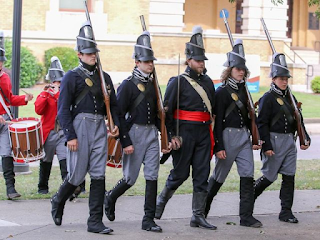Neamathla, General Gaines, and Washington Irving!
by Dale Cox
 |
| Neamathla (Eneah Emathla) Primary Chief of Fowltown |
The effective strengths of the Fourth and Seventh Infantry Regiments of the U.S. Army began arriving at Fort Scott on today's Lake Seminole in Southwest Georgia 202 years ago today. The soldiers did not know it, but they were coming to start a war.
Maj. Gen. Edmund P. Gaines, a hero of the War of 1812, commanded the march, which started at Camp or Fort Montgomery in the Tensaw settlement of what is now Alabama. He was under orders from the administration of President James Monroe to kidnap the Red Stick Creek chief Neamathla (Eneah Emathla) and some of his leading men.
Neamathla was the principal chief of Fowltown, a Lower Creek village that had recently resettled on the swamps of Four Mile Creek about 3-4 miles south of present-day Bainbridge, Georgia. He and his followers sided with the Prophet Josiah Francis during the Creek War of 1813-1814 but were defeated at the Battle of Uchee Creek and forced to evacuate to the Florida borderlands.
Rearmed by the British during the closing months of the War of 1812, they refused to evacuate their lands as required by the Treaty of Fort Jackson, which seized more than 22 million acres from the Creeks. Neamathla had not signed that document. "The land is mine," he told Maj. David E. Twiggs of the U.S. Army that summer, "I am directed by the Powers Above to defend it."
 |
| Maj. Gen. Edmund P. Gaines, USA Photographed later in life. National Archives. |
Hindsight shows that everyone involved in the U.S. side of the dispute - from subordinate officers at the fort on the Flint to the highest officials in the Monroe Administration - underestimated Neamathla. The fighting that would take place at Fowltown and on the Apalachicola River over the next eleven days would show by how much.
Perhaps the best account of the chief was written by the famed author Washington Irving. Remembered today for The Legend of Sleepy Hollow and other works, Irving interviewed Florida Gov. William P. Duval about his later interactions with the chief. Duval met Neamathla as lands were being selected for Florida’s capital city of Tallahassee:
…He was a remarkable man; upward of sixty years of age, about six feet high, with a fine eye, and a strongly-marked countenance, over which he possessed great command. His hatred of white men appeared to be mixed with contempt: on the common people, he looked down with infinite scorn. He seemed unwilling to acknowledge any superiority of rank or dignity in Governor Duval, claiming to associate with him on terms of equality as two great chieftains.[i]
 |
| Washington Irving, the noted American writer who penned a fascinating account of Neamathla. Library of Congress. |
…This country belongs to the red man; and if I had the number of warriors at my command that this nation once had, I would not leave a white man on my lands. I would exterminate the whole. I can say this to you, for you can understand me: you are a man; but I would not say it to your people. They’d cry out I was a savage, and would take my life. They cannot appreciate the feelings of a man that loves his country.[ii]
Duval was attempting to arrange the movement of Neamathla and his followers from a village site at Tallahassee to a new reservation established for them near the Ochlockonee River in Gadsden County, Florida. The chief’s voice grew louder and louder until it could be heard over the entire village as he made clear that he was willing to fight to the death to defend the lands of his people:
…He held in his hand a long knife, with which he had been rasping tobacco; this he kept flourishing backward and forward, as he talked, by way of giving effect to his words, brandishing it at times within an inch of the governor’s throat. He concluded his tirade by repeating, that the country belonged to the red men, and that sooner than give it up, his bones and the bones of his people should bleach upon its soil.[iii]
Captured by U.S. and Alabama militia troops, he was placed in chains and marched west on the Trail of Tears. An officer who saw him wrote that the chief was over 80 years old but never uttered a complaint despite the weight of his chains. He reached what is now Oklahoma during the brutal winter of 1836-1837. One of the final mentions of him to appear in U.S. Army records is a plea for his people to receive the blankets that they had been promised. They were suffering in the snow and ice and had nothing with which to cover themselves.
Editor's Note: The events of November 1817 are commemorated by the annual Scott 1817 Seminole War Battle Reenactment at Chattahoochee, Florida. This year's event is scheduled for December 6-8 and will feature an Education Day for school and home school students on Friday, December 6, followed by public days on Saturday and Sunday, December 7 and 8. Activities take place at River Landing Park and feature living history encampments, demonstrations, exhibits, a mobile museum, the authentic 19th-century replica keelboat Aux Arc ("Ozark"), and battle reenactments on both Saturday and Sunday. All activities are free to the public.
For more information, please visit https://scott1817.com. This video will give you a quick 30-second preview:
[i] Washington Irving, “Conspiracy of Neamathla” in The Works of Washington Irving, Author’s Revised Edition, Volume XVI, Wolfert's Roost, New York, G.P. Putnam, 1863, page 297.
[ii] Ibid., pp. 297-298.
[iii] Ibid., pp. 301-302.

No comments:
Post a Comment